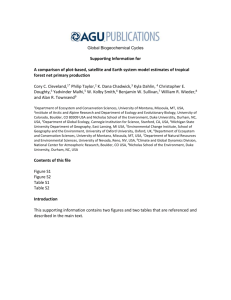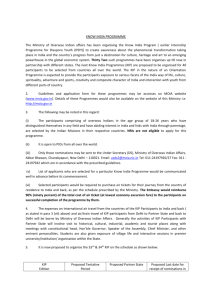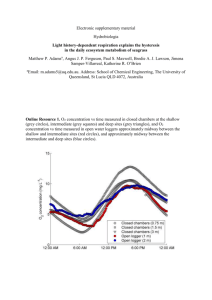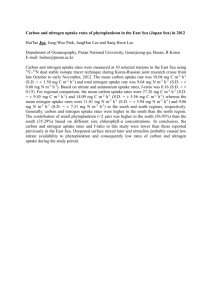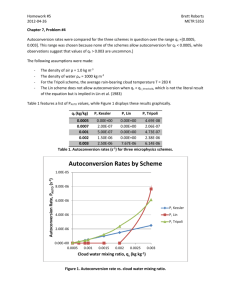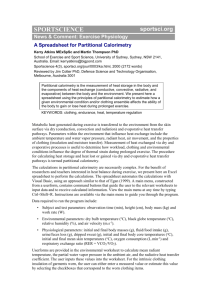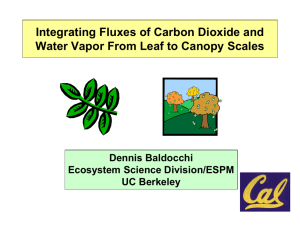Lake_erie_sensor_AGU_2013_presentation
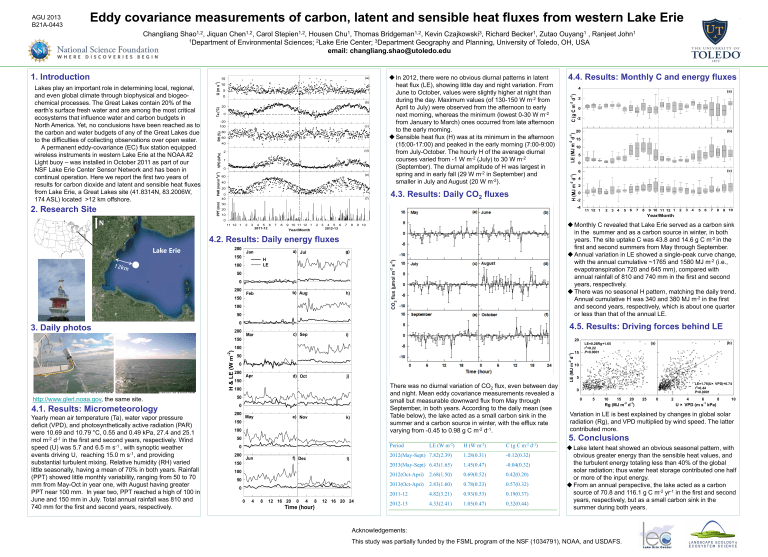
AGU 2013
B21A-0443
Eddy covariance measurements of carbon, latent and sensible heat fluxes from western Lake Erie
Changliang Shao
1,2
, Jiquan Chen
1,2
, Carol Stepien
1,2
, Housen Chu
1
, Thomas Bridgeman
1,2
, Kevin Czajkowski
3
, Richard Becker
1
, Zutao Ouyang
1
, Ranjeet John
1
1
Department of Environmental Sciences;
2
Lake Erie Center;
3
Department Geography and Planning, University of Toledo, OH, USA email: changliang.shao@utoledo.edu
1. Introduction
Lakes play an important role in determining local, regional, and even global climate through biophysical and biogeochemical processes. The Great Lakes contain 20% of the earth’s surface fresh water and are among the most critical ecosystems that influence water and carbon budgets in
North America. Yet, no conclusions have been reached as to the carbon and water budgets of any of the Great Lakes due to the difficulties of collecting observations over open water.
A permanent eddy-covariance (EC) flux station equipped wireless instruments in western Lake Erie at the NOAA #2
Light buoy – was installed in October 2011 as part of our
NSF Lake Erie Center Sensor Network and has been in continual operation. Here we report the first two years of results for carbon dioxide and latent and sensible heat fluxes from Lake Erie, a Great Lakes site (41.8314N, 83.2006W,
174 ASL) located >12 km offshore.
2. Research Site
N
3. Daily photos http://www.glerl.noaa.gov
, the same site.
Lake Erie
4.1. Results: Micrometeorology
Yearly mean air temperature (Ta), water vapor pressure deficit (VPD), and photosynthetically active radiation (PAR) were 10.69 and 10.79 °C, 0.55 and 0.49 kPa, 27.4 and 25.1 mol m -2 d -1 in the first and second years, respectively. Wind speed (U) was 5.7 and 6.5 m s -1 , with synoptic weather events driving U, reaching 15.0 m s -1 , and providing substantial turbulent mixing. Relative humidity (RH) varied little seasonally, having a mean of 70% in both years. Rainfall
(PPT) showed little monthly variability, ranging from 50 to 70 mm from May-Oct in year one, with August having greater
PPT near 100 mm. In year two, PPT reached a high of 100 in
June and 150 mm in July. Total annual rainfall was 810 and
740 mm for the first and second years, respectively.
15
10
5
0
20
0
-20
100
80
60
40
2
1
0
60
40
20
0
40
30
20
10
0
2011-12 2012-13
Year/Month
4.2. Results: Daily energy fluxes
200
Jan a) Jul
150
100
H
LE
50
Feb
Mar
200
150
100
50
Apr
0
200
May
150
100
50
0
200
Jun
150
100
50
0
0
200
150
100
50
0
200
150
100
50
0 b) Aug c) Sep d) Oct e) Nov f) Dec g) h) i) j) k) l)
0 4 8 12 16 20 0 4 8 12 16 20 24
Time (hour)
(a)
(b)
(c)
(d)
(e)
(f)
In 2012, there were no obvious diurnal patterns in latent heat flux (LE), showing little day and night variation. From
June to October, values were slightly higher at night than during the day. Maximum values (of 130-150 W m -2 from
April to July) were observed from the afternoon to early next morning, whereas the minimum (lowest 0-30 W m -2 from January to March) ones occurred from late afternoon to the early morning.
Sensible heat flux (H) was at its minimum in the afternoon
(15:00-17:00) and peaked in the early morning (7:00-9:00) from July-October. The hourly H of the average diurnal courses varied from -1 W m -2 (July) to 30 W m -2
(September). The diurnal amplitude of H was largest in spring and in early fall (29 W m -2 in September) and smaller in July and August (20 W m -2 ).
4.3. Results: Daily CO
2
fluxes
4.4. Results: Monthly C and energy fluxes
4
(a)
2
0
-2
20
15
10
(b)
5
0
6
0
-2
4
2
(c)
-4
11 12 1 2 3 4 5 6 7 8 9 10 11 12
Year/Month
1 2 3 4 5 6 7 8 9 10
Monthly C revealed that Lake Erie served as a carbon sink in the summer and as a carbon source in winter, in both years. The site uptake C was 43.8 and 14.6 g C m -2 in the first and second summers from May through September.
Annual variation in LE showed a single-peak curve change, with the annual cumulative ~1765 and 1580 MJ m -2 (i.e., evapotranspiration 720 and 645 mm), compared with annual rainfall of 810 and 740 mm in the first and second years, respectively.
There was no seasonal H pattern, matching the daily trend.
Annual cumulative H was 340 and 380 MJ m -2 in the first and second years, respectively, which is about one quarter or less than that of the annual LE.
4.5. Results: Driving forces behind LE
20
15
LE=0.26Rg+1.65
r
2
=0.22
P<0.0001
(a) (b)
10
There was no diurnal variation of CO
2 flux, even between day and night. Mean eddy covariance measurements revealed a small but measurable downward flux from May through
September, in both years. According to the daily mean (see
Table below), the lake acted as a small carbon sink in the summer and a carbon source in winter, with the efflux rate varying from -0.45 to 0.98 g C m -2 d -1 .
Period LE (W m -2 ) H (W m -2 )
2012(May-Sept) 7.82(2.39) 1.28(0.31)
2013(May-Sept) 6.43(1.65) 1.45(0.47)
2012(Oct-Apri) 2.68(1.50)
2013(Oct-Apri) 2.83(1.60)
2011-12
2012-13
4.82(3.21)
4.33(2.41)
0.69(0.52)
0.78(0.23)
0.93(0.53)
1.05(0.47)
C (g C m -2 d -1 )
-0.12(0.32)
-0.04(0.32)
0.42(0.20)
0.57(0.32)
0.19(0.37)
0.32(0.44)
5
0
0 5 10 15 20
Rg (MJ m
-2
d
-1
)
25 0 2 4
LE=1.76(U× VPD)+0.74
r
2
=0.44
P<0.0001
6
U × VPD (m s
-1
kPa)
8 10
Variation in LE is best explained by changes in global solar radiation (Rg), and VPD multiplied by wind speed. The latter contributed more.
5. Conclusions
Lake latent heat showed an obvious seasonal pattern, with obvious greater energy than the sensible heat values, and the turbulent energy totaling less than 40% of the global solar radiation; thus water heat storage contributed one half or more of the input energy.
From an annual perspective, the lake acted as a carbon source of 70.8 and 116.1 g C m -2 yr -1 in the first and second years, respectively, but as a small carbon sink in the summer during both years.
Acknowledgements:
This study was partially funded by the FSML program of the NSF (1034791), NOAA, and USDAFS.
